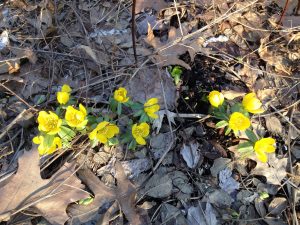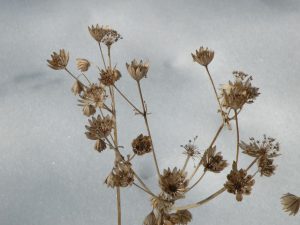
My snowdrops pushed their way through fallen leaves. The buds opened the next day.

The bright yellow of Eranthis is so cheery.

The bright purple of Crocus tommasianus really catches your eye.
It’s finally March. Therefore, winter is mostly behind us. We’ve even had a few teaser days that spur the urge to go out and start working in our gardens BUT, DON’T! The tiny, early bulbs like Galanthus (Snowdrops), Eranthis (Winter Aconite), and Crocus tommasianus are blooming and lifting our spirits so it’s time for observing and photographing without stepping into the garden. Walking on wet ground only compacts it and thus lessens its aeration.
It is definitely time to start accustoming your body’s muscles to the exertions that will be part of your spring cleanup. I find that knee bends and bendovers, done daily, from now until gardening time, will lessen aches and pains. Also helpful for me is two Advil before I go out and two more when I finish.

Astrantia deadheads
For those of us who don’t believe in fall cleanup, Spring becomes the busiest time of year but waiting is essential. Winter may be waning but I suspect that it will hit us again this month. We almost always get more snow in March and sometimes even in April. Meanwhile insects and birds still need the food that deadheads provide as well as the shelter.
This is a good time to evaluate what dormant pruning needs to be done. Do you have shrubs that are reaching out into the driveway or will be by midsummer? Do you have shrubs that are already above your window sills or will be by midsummer?

This Taxus probably hasn’t been pruned in years and is partially obscuring a decorative wall.
The rule of thumb is to prune those woody landscape plants that will bloom on this year’s wood. Some of the common shrubs you prune while dormant include Glossy Abelia, Barberry, Summersweet (Clethra), Smokebush (Cotinus), Spirea, Cotoneaster, and late viburnums (such as Blackhaw and American Cranberry Bush). Depending on how high you want these to grow, you can prune them back as far as just above the first pair of buds above the soil. This also holds for evergreens. Between now and the beginning of April is the perfect time to prune overgrown yews (Taxus) and junipers.
Those shrubs that bloom on the previous season’s wood, should be pruned after they bloom in late spring or early summer. Examples of those that you should prune after bloom are lilacs, forsythia, rhododendrons, and early viburnums. Prune these right after they bloom, as they will then start forming flower buds for the following year. Pruning these during summer or fall will cut off next year’s flowers. I often see this with forsythia, which grow rampant and gardeners “shape” during the growing season. Of course, broken branches can be pruned off now in winter.
An excellent primer on pruning advice is from the High Country Gardens website. Just scroll down to the bottom on the left for Gardening Blog, scroll down to Our Most Popular Gardening Articles, scroll down again to Garden Care: The Essentials, and then finally click on Easy Spring Gardening Tips: Clean, Prune, Divide.
When weather permits and you venture out to start spring cleanup, pull as many weeds as you can in order to get a head start on them. Perennials weeds need to be dug because they usually have deep, strong roots. If you have too much bare ground, think about what else you can plant to fill the space or using a groundcover. Bare ground is just an invitation to weeds.
 Whether its cold and snowing, chilly and raining, or warm and sunny, keep dreaming. Spring is coming but try to be realistic. April in Cleveland is often cool and rainy. As T.S.Eliot said in The Wasteland: “April is the cruelest month…… mixing memory and desire, stirring dull roots with spring rain.”
Whether its cold and snowing, chilly and raining, or warm and sunny, keep dreaming. Spring is coming but try to be realistic. April in Cleveland is often cool and rainy. As T.S.Eliot said in The Wasteland: “April is the cruelest month…… mixing memory and desire, stirring dull roots with spring rain.”
Just remember, it’s not yet time for Ready, Set, Go.


1 Comment